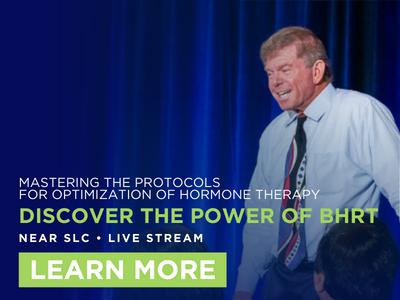
Estrogen Dominance in Men

If you are interested in learning more about the value and efficacy of Bioidentical hormones in HRT as an alternative to medication-based therapies, please consider our four part hormone optimization workshop series.
The Role of Testosterone on E2 Levels
Testosterone replacement therapy has a significant role in protecting aging men’s health, including greater protection against heart disease, diabetes, and obesity.123 However, it naturally increases estrogen levels in men, which has brought the benefits of testosterone therapy into question.
You may have heard the warning that high estrogen levels cause prostate cancer in men, but research supporting this claim is unclear. Some studies indicate that high estrogen levels can increase the development of prostate cancer cells, while other research finds high estrogen levels are not found in men with prostate cancer. High estrogen levels may be considered a health risk, but low estrogen levels can also be detrimental to men’s health. The body needs estrogen to avoid cardiovascular disease, type 2 diabetes, osteoporosis, and metabolic syndrome.45
Next we will take a look at the two different arguments to understand the effects of raising estrogen levels via testosterone therapy.
Argument A: Raising Estrogen Levels is Harmful
As men age, circulating levels of estradiol increase and free testosterone levels decrease in the body. This sharp increase in estrogen has been related to prostate cancer. Prostate cancer has been suggested to originate from the presence of androgens, because testosterone is converted into estrogen by the enzyme aromatase.6 This depletes free testosterone levels and increases estrogen levels. However, the active form of testosterone, 5alpha-dihydrotestosterone, is not aromatized into estrogen and does not increase prostate cancer risks.7 Estrogen treatment has been shown to damage prostate DNA in animal studies and it is suggested that androgens act as a strong tumor promoter when estrogen, or specifically estradiol-17beta, is present.7 However, a closer look at these claims shows testosterone actually plays a significant role in sustaining prostate health and that androgens do not cause prostate cancer.
Argument B: High Estrogen Levels in Men are Actually Protective
While it has been argued testosterone therapy increases the risk of prostate cancer by raising estrogen levels, research has also shown the opposite is true. Low levels of testosterone increases prostate cancer risks. A literature review found that there is a limited capacity for androgens to stimulate the growth of prostate cancer cells.8 Another review of research did not find a significant association between testosterone or estrogen levels and prostate cancer.9 Only men that currently have prostate cancer should avoid testosterone therapy, as this is the time when androgens may further proliferate cancer cells.
Several studies indicate that low estrogen levels in men can be detrimental and raising estrogen levels has protective benefits, such as strong bones, sustained cognitive function, and cardiovascular health. In fact, increasing estrogen levels is not harmful when optimal testosterone levels are present. The ratio of estrogen to testosterone is what matters most, as low testosterone and high estrogen blocks testosterone receptor sites.10 Testosterone therapy is a beneficial way to restore healthy testosterone levels and balance the testosterone/estrogen ratio. Testosterone therapy was given to 207 men between the ages of 40 to 83, finding the therapy had a significant decrease on prostate volume, prostate-specific antigens (PSA) levels, and lower urinary tract symptoms.11
Conclusion: Optimal Hormone Balance
So, what is the final verdict? Estrogen is not harmful to men. This can best be explained by Dr. Neal Rouzier, who in his most recent webinar stated,“Many conclude that estrogen may be responsible for the high prevalence of prostate cancer in men. That has been extrapolated to [imply that] estrogen causes cancer in men and now everyone thinks that it’s bad and everyone is on this kick to lower estrogen in men to protect against that. What does the literature say?…All of the studies to-date, 50 years of studies, where testosterone has been utilized to increase estrogen levels, show it aromatizes to estradiol and all of these levels [testosterone, estradiol and estrogen] are increased. There is no study to support any increased risk of cancer of the prostate when estrogen levels are raised.”
It is only when estrogen levels are too high and testosterone levels are too low that negative effects can occur in men’s health [Estrogen Dominance in Men]. Testosterone levels should be restored to their optimal range to avoid the detrimental effects of this imbalance. “Again, 50 years of studies demonstrate that testosterone administration, which raises serum estrogen levels, does not cause prostate cancer.”10
If you are interested in learning more about the value and efficacy of BHRT as an alternative to medication-based therapies, please consider our four part Hormone Optimization Workshop Series, and start training with us at Part I: Discover the Power of BHRT.
References:
- Wang C, Cunningham G, Dobs A, et al. Long-term testosterone gel (AndroGel) treatment maintains beneficial effects on sexual function and mood, lean and fat mass, and bone mineral density in hypogonadal men. J Clin Endocrinol Metab. 2004 May;89(5):2085-2098
- Darby E, Anawalt BD. Male hypogonadism: an update on diagnosis and treatment. Treat Endocrinol. 2005;4(5):293-309.
- Watt PJ, Hughes RB, et al. A holistic programmatic approach to natural hormone replacement. Fam Community Health . 2003; 25(1):53-63.
- Miner MM, Seftel AD. Testosterone and ageing: what have we learned since the Institute of Medicine report and what lies ahead? Int J Clin Pract. 2007 Apr;61(4):622632.
- Amin S, Zhang Y, Felson DT, Sawin CT, et al. Estradiol, testosterone, and the risk for hip fractures in elderly men from the Framingham Study. Am J Med. 2006 May;119(5):426-433.
- Shibata Y, Ito K, Suzuki K, Nakano K, et al. Changes in the endocrine environment of the human prostate transition zone with aging: simultaneous quantitative analysis of prostatic sex steroids and comparison with human prostatic histological composition. Prostate. 2000 Jan;42(1):45-55.
- Bosland MC. Sex steroids and prostate carcinogenesis: integrated, multifactorial working hypothesis. Ann NY Acad Sci. 2006 Nov;1089:168-176.
- Morgentaler A, Traish AM. Shifting the paradigm of testosterone and prostate cancer: the saturation model and the limits of androgen-dependent growth. Eur Urol. 2009 Feb;55(2):310-320.
- Roddam AW, Allen NE, Appleby P, Key TJ, et al. Insulin-like growth factors, their binding proteins, and prostate cancer risk: analysis of individual patient data from 12 prospective studies. Ann Intern Med. 2008 Oct;149(7):461-471.
- Rouzier N. (2007). How to achieve healthy aging. Salt Lake City, UT: WorldLink Medical Publishing.
- Pechersky AV, Mazurov VI, Semiglazov VF, Karpischenko AI, et al. Androgen administration in middle-aged and ageing men: effects of oral testosterone undecanoate on dihydrotestosterone, oestradiol and prostate volume. Int J Androl. 2002 Apr;25(2):119-125.
